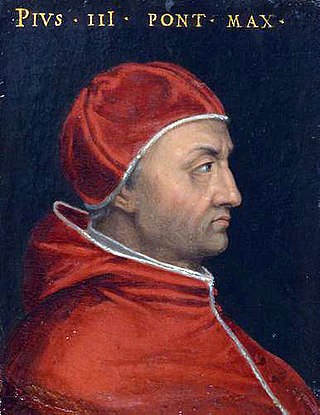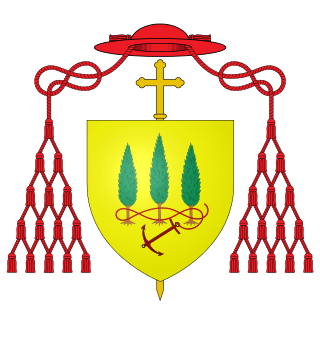This article relies largely or entirely on a single source .(June 2017) |
Stefano Nardini (died 1484) (called the Cardinal of Milan) was an Italian Roman Catholic bishop and cardinal.
This article relies largely or entirely on a single source .(June 2017) |
Stefano Nardini (died 1484) (called the Cardinal of Milan) was an Italian Roman Catholic bishop and cardinal.
Stefano Nardini was born in Forlì. [1] He received a doctorate of both laws. [1]
As a young man, Nardini served in the military, before joining the ecclesiastical estate and traveling to Rome. [1] He became a canon of Ferrara Cathedral, and later General Treasurer of the Marche. [1] During the pontificate of Pope Callixtus III, he was governor of Romagna. [1] Under Pope Pius II, he was a referendary, and later, a protonotary apostolic. [1] He then served as Pius II's nuncio to Germany; the pope wrote to him on 15 July 1459 about the advance of the Ottoman Empire in the Kingdom of Bosnia. [1]
On 13 November 1461 he was elected Archbishop of Milan. He occupied that see until his death. [1] He then served as a nuncio in the Kingdom of Aragon, in which capacity he successfully sought the derogation of a pragmatic sanction that endangered the freedom of the church. [1] In July and August 1464, he accompanied the pope to Ancona. [1]
Following the death of Pope Pius II, he returned to Rome for the papal conclave of 1464 that elected Pope Paul II. [1] During that conclave, the College of Cardinals had agreed that the number of cardinals should be fixed at 24; Archbishop Nardini and Teodoro Lelio, Bishop of Treviso, advised the new pope in September 1464 not to agree to this limitation. [1] Paul II named Nardini nuncio extraordinary to the Kingdom of Naples. [1] From April 1467 to June 1468, he resided in Paris as papal legate to the Kingdom of France. [1] He was present in Rome when Paul II died in July 1471 and the College of Cardinals named him temporary governor of Rome. [1] In the papal conclave of 1471, the College of Cardinals elected Pope Sixtus IV as the new pope. [1]
In the consistory of 7 May1473, Sixtus IV made Nardini a cardinal priest; he received the red hat and the titulus of Sant'Adriano al Foro (a deaconry elevated pro illa vice to titulus). [1]
As cardinal, he built the Palazzo Nardini on the Via del Governo Vecchio, next to the Palazzo Taverna . [1] On 10 June 1476 he accompanied the pope to Viterbo, and later to Foligno, because of an outbreak of bubonic plague in Rome. [1] In 1476, he opted for the titulus of Santa Maria in Trastevere. [1] He was Camerlengo of the Sacred College of Cardinals from 8 January 1481 until 7 January 1482. [1] In 1483, he founded the Collegio Nardini. [1]
He participated in the papal conclave of 1484 that elected Pope Innocent VIII. [1] The new pope named him legate to Avignon, but he died before he could perform his legation. [1]
He died in Rome on 22 October 1484. [1] He is buried in St. Peter's Basilica. [1]

Pope Pius III, born Francesco Todeschini, was head of the Catholic Church and ruler of the Papal States from 22 September 1503 to his death. At just twenty-six days, he had one of the shortest pontificates in papal history.

Pope Sixtus IV was head of the Catholic Church and ruler of the Papal States from 9 August 1471 to his death, in August 1484. His accomplishments as pope included the construction of the Sistine Chapel and the creation of the Vatican Library. A patron of the arts, he brought together the group of artists who ushered the Early Renaissance into Rome with the first masterpieces of the city's new artistic age.

Pope Paul II, born Pietro Barbo, was head of the Catholic Church and ruler of the Papal States from 30 August 1464 to his death. When his maternal uncle became Pope Eugene IV, Barbo switched from training to be a merchant to religious studies. His rise in the Church was relatively rapid. Elected pope in 1464, Paul amassed a great collection of art and antiquities.

In the papal conclave held from 14 to 16 June 1846, Giovanni Maria Mastai Ferretti, Bishop of Imola, was elected on the fourth ballot to succeed the recently deceased Gregory XVI as pope. He took the name Pius IX. Of the 62 members of the College of Cardinals, 52 assembled in the Quirinal Palace, one of the papal palaces in Rome and the seat of two earlier 19th century conclaves. The conclave was the last to elect a ruler of the Papal States, the extensive lands around Rome and Northern Italy which the Catholic Church governed until 1870.

Ascanio Maria Sforza Visconti was an Italian Cardinal of the Catholic Church. Generally known as a skilled diplomat who played a major role in the election of Rodrigo Borgia as Pope Alexander VI, Sforza served as Vice-Chancellor of the Holy Roman Church from 1492 until 1505.

Niccolò Fortiguerra was an Italian papal legate, military commander, and Cardinal.

Marco Barbo of Venice was a cousin and lifetime follower of Cardinal Pietro Barbo, who became Pope Paul II in 1464. Marco was appointed Bishop of Vicenza on 17 September 1464; appointed a cardinal of the Roman Catholic Church on 18 September 1467; and Patriarch of Aquileia in 1470. He was a principal papal administrator.

Francesco Gonzaga was an Italian bishop and a Cardinal of the Roman Catholic Church during the reigns of Popes Pius II, Paul II and Sixtus IV.

Angelo Capranica was an Italian Roman Catholic bishop and cardinal.

Berardo Eroli (1409–1479) was an Italian Roman Catholic bishop and cardinal.

Bartolomeo Roverella (1406–1476) was an Italian Roman Catholic bishop and cardinal.

Amico Agnifili was an Italian Roman Catholic bishop and cardinal.

Giovanni Michiel was an Italian Roman Catholic cardinal and bishop.
Giacopo Antonio Venier (1422–1479) was an Italian Roman Catholic bishop and cardinal.

Giovanni Arcimboldi is called the Cardinal of Novara or the Cardinal of Milan and was an Italian Roman Catholic bishop and cardinal. He served many times as the legate to Perugia and was both a Senator of Milan and ran the archdiocese from 1485-1488.
Philibert Hugonet was a French Roman Catholic bishop and cardinal.

Pedro Ferris (1416–1478) was a Spanish Roman Catholic bishop and cardinal.
Joan Margarit i Pau, or in Spanish Juan Margarit y Pau, was a prominent Catalan prelate, a bishop of Girona and a cardinal.

Giovanni Ricci was an Italian Roman Catholic bishop and cardinal.
Scipione Lancelotti (1527–1598) was an Italian who became a cardinal within the Roman Catholic Church.